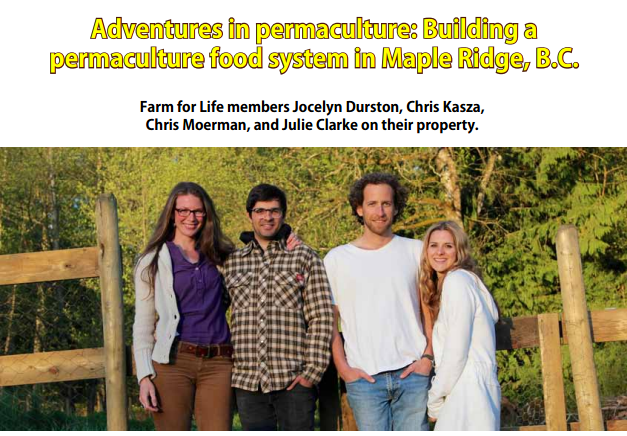A few months ago, I was invited to write an article about our permaculture experiment for The Footprint Press, a local non-profit community newspaper. Issue 9 has just been released, including the article I wrote. You can read it online at The Footprint Press. I’ve also reprinted it below. Thanks Footprint Press for letting us share some of our story through your pages!
Adventures in permaculture: Building a permaculture food system in Maple Ridge, B.C.
The view from our house is not a very typical one for four university-educated, thirty-somethings. Instead of city skyscrapers and suburban townhomes, we look out over a classic red barn, a DIY polytunnel, a variety of fruit and vegetable gardens, and a motley crew of free-range chickens and ducks. Some may call it idyllic. We call it our in-the-making permaculture paradise.
My name is Jocelyn Durston and I’m one of four friends who make up The Farm for Life Project – a homesteading and market gardening experiment in Maple Ridge, B.C.
Currently in its third year, The Farm for Life Project has evolved substantially from where it first began. What started out as a personal food-growing venture now includes a small market garden business, a young food forest, and a variety of learn-as-you-go construction projects. Our gardens feed ourselves, other community members, and serve as a learning space for local school groups and gardening classes. Considering we started with a blank slate of heavily-grassed acreage and very inexperienced eagerness, it’s rewarding to see where we are now.
Our food-growing adventure began out of shared concerns about the state of our food and the earth. After learning about modern agriculture – the heavy chemical use, environmental degradation, inhumane animal treatment, injustices towards small farmers, and the risky business of GMOs, we decided to respond to our concerns in a personal, practical way – by growing our own food.
In addition to myself, project members include Chris Moerman and Julie Clarke (the landowners), and my partner Chris Kasza (fellow renter). Together, we live on 2.5 acres of ALR land in east Maple Ridge, and devote a lot of our time to growing food and building strong relationships within the community.
From the beginning, our efforts have been heavily inspired by permaculture. Founder Bill Mollison describes permaculture as, “…the conscious design and maintenance of agriculturally productive ecosystems which have the diversity, stability, and resilience of natural ecosystems”. In other words, by looking to nature for inspiration, we can design sustainable food-producing systems that support human life and all other life on earth.
With this concept in mind, we have been experimenting with an array of nature-inspired design ideas. Some of the more common gardening techniques we use include lasagna gardening, a no-dig method that builds beds out of layers of natural mulching and compostable materials, as well as livestock assistance, allowing our chickens to fertilize and till our gardens while our ducks keep the local slug population to a minimum. Some of the lesser-known, but exciting permaculture designs we use include a herb spiral which is a tiered, spiralling, multi-microclimate garden bed, hugelkultur beds which are built to mimic the rich, natural soil-building capabilities of forest floors, and a young food forest which includes nut trees, fruit trees, berry bushes, perennial herbs, vegetables and flowers.
These methods bring different plant varieties together to work side-by-side, enriching the soil and attracting important microorganisms, insects, and birds. Recognizing that diversity brings strength and resilience, as well as the fact that humans have become isolated from nature, we have also been intentional about creating wildlife-friendly zones. We have a small forest that is left mostly untouched, an intentional pile of logs to provide habitat for nesting ducks and other small animals, little hills of stones to attract snakes, and multiple ponds that host a loud chorus of frogs and provide swimming spots for our own ducks as well as two pairs of wild mallards. In the past three years, we have witnessed an encouraging increase in the variety of pollinators and birds on the property, and have appreciated the presence of bears, deer, coyotes, raccoons, owls, and hawks.
Learning about permaculture and applying it in practical ways in our gardens has helped us feel more connected to the earth and has given us a stronger sense of responsibility for it. We strongly believe that the adoption of permaculture philosophies are an important step in the right direction to provide for human food needs in a way that works with, rather than against, the earth.
